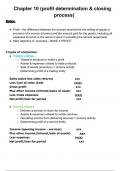Other
FinAcc 188 Notes (Chapters 10-20)
- Course
- FinACC 188 (188)
- Institution
- Stellenbosch University (SUN)
This set of notes includes chapters 10 to 20 of the FinAcc 188 course. It includes diagrams, explanations, helpful tips, and much more. I personally use these notes to study and they have proved very useful in the past. I used the textbook, lecture slides and class notes to compile this document. T...
[Show more]



